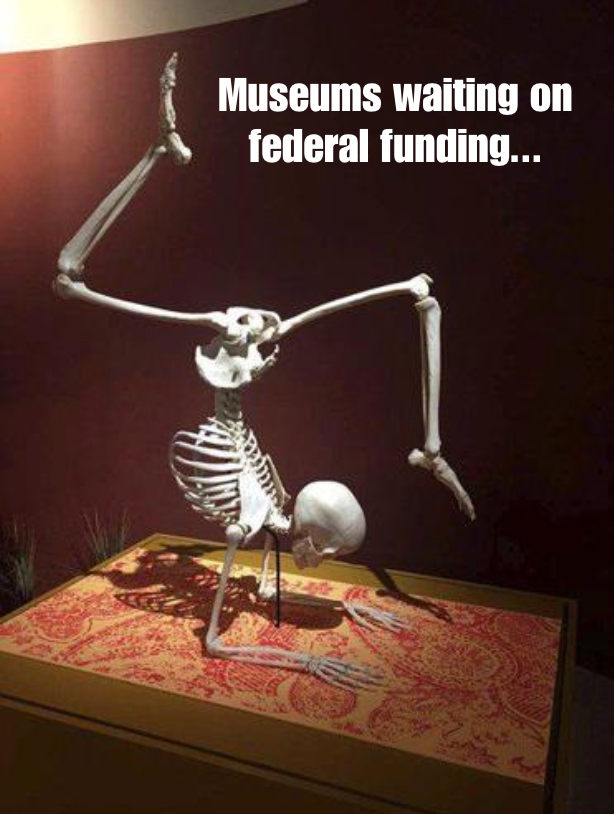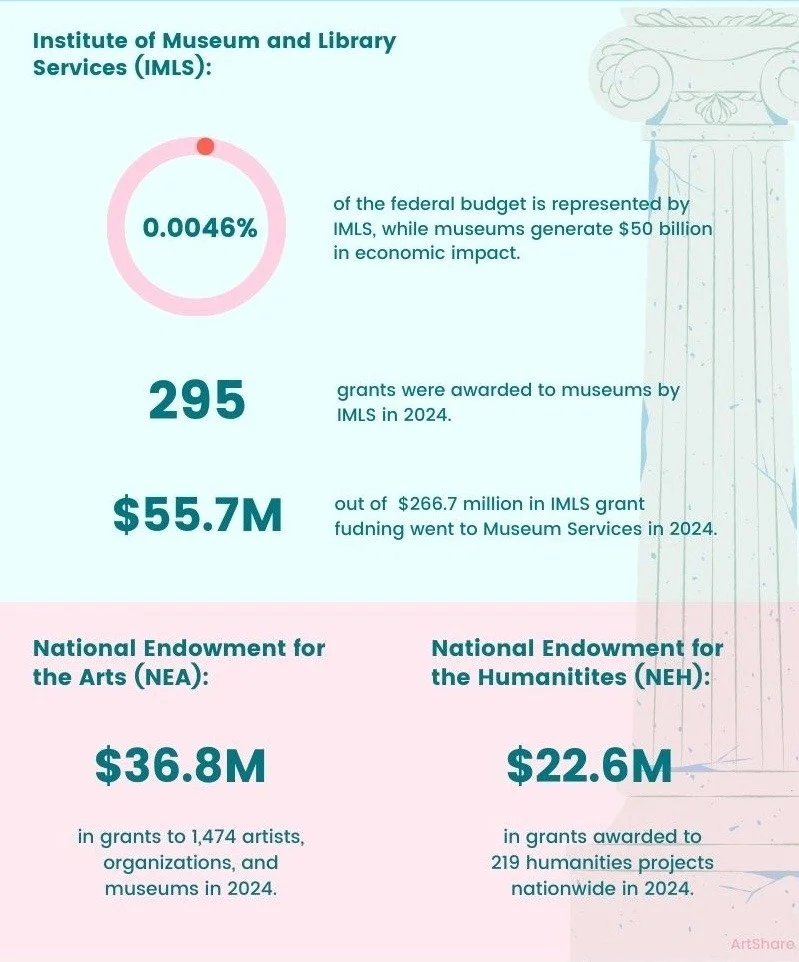What’s the Deal With Federal Funding?
Anyone who has had the pleasure of dealing with the federal government knows that nothing is quick or easy about it, despite this, many museums use federal funding as a financial anchor. Federal funding for museums has always been turbulent yet vital. The recent attempts to defund agencies that support museums are nothing new and the museum field's response to the issue is nothing new either. Federal funding is only the tip of the iceberg of a larger issue. The question now is will museums wait until they are nearly extinct to do something about it? This is the first blog in a series of blogs discussing the impact and implications of museums losing federal funding and how they can pivot.
When the Rug Gets Pulled From Under You
Executive orders, often perceived as "instant law," play a significant role in shaping the federal government's operations, including funding decisions. While not legislation and requiring no Congressional approval, these orders can significantly impact institutions dependent on federal support, adding another layer of complexity to their financial landscape. The executive order instructed federal agencies to scrutinize all grants with the intention of reducing them "to the fullest extent allowed by law."This directive raised concerns about the continuity of funding for various cultural programs.
Without federal grants, many museums would struggle to fund their operations, exhibitions, and educational programs. The National Endowment for the Arts (NEA) acknowledged this uncertain climate and is actively reviewing the executive orders and related documents to ensure compliance while fulfilling required reporting obligations. This highlights the precarious situation for institutions reliant on federal support.
Band-aid for a Bullet Wound
In a crucial development, the Supreme Court intervened to block the proposed pause on federal grants and loans. For museums, this ruling was a lifeline, allowing them to continue accessing essential funds needed for various operations, from curating exhibitions to running educational programs. The relief, however, is temporary and highlights the ongoing vulnerability of these organizations to policy changes.
These executive orders bring to light the broader issue of dependency on the federal government's support in the arts and cultural sectors. The Center for Photography at Woodstock’s Executive Director, Brian Wallis, told Hyperallergic, “In our case, federal funding represents nearly 10 percent of the annual CPW budget. Wholesale cuts to that funding will be crushing.” While the Supreme Court's block provided a temporary measure, it did not address the underlying tensions and differing views on the allocation of public funds for cultural activities. Efforts to defund agencies like IMLS, NEA, and NEH, raise alarms about the future viability of cultural programming across the country. The future of federal support remains uncertain, as ongoing political shifts and economic challenges could further influence funding priorities.
First they came for IMLS...
An executive order issued by the Trump Administration in March, called for IMLS to be “eliminated to the maximum extent consistent with applicable law.” IMLS, the nation's federal agency for America's museums and libraries, plays a pivotal role in providing grants that sustain the operations and outreach efforts. In 2024, IMLS awarded $55.7M to 295 museum service grants across the country. AAM released a statement pointing out that “IMLS represents just 0.0046% of the federal budget, while museums generate $50 billion in economic impact.”
Since the executive order, many museums have been notified that their grants have been terminated. These grants support a wide range of activities, from educational initiatives and community engagement programs to the preservation of historical artifacts and collections.Museums and libraries, which depend on this support, face significant challenges in maintaining their offerings. The Parrish Art Museum’s Executive Director, Mónica Ramírez-Montagut, told Hyperallergic that the institution lost an essential IMLS grant for their ACCESS Parrish program that supports visitors with cognitive and physical disabilities, cancer patients, and many others.
The potential loss of IMLS funding could lead to reduced hours, staffing cuts, and the cancellation of planned exhibits and events. This would affect not only the institutions directly but also the communities they serve, particularly in underserved and rural areas where such programs are often the only cultural resources available.
A Tale as Old as Time, but What’s New?
Efforts to reduce funding for the cultural sector have a long history. Various administrations have attempted to scale back financial support for museums, libraries, and non-profits. For instance,during the Reagan administration in the 1980s, there was a significant effort to reduce federal funding for cultural programs. This effort was countered by strong advocacy from professional organizations like the American Library Association (ALA) and the American Alliance of Museums (AAM), which lobbied Congress effectively to maintain essential funding levels. In response to proposed cuts during the Obama administration, cultural institutions worked closely with local governments and other stakeholders to diversify their funding sources through grants from philanthropic foundations to alleviate potential negative impacts from reduced federal funding.
Such reductions have historically led to tough choices, such as scaling back community outreach or cutting staffing levels. Over the years, the cultural sector has had to adapt to these financial challenges through strategic planning and increased advocacy, but will it be enough this time?
Master of Your Fate
Museums should know better than anyone that history repeats itself, yet we keep using old solutions to solve old problems. Museums have increasingly had to get creative and entrepreneurial to ensure their survival amidst financial constraints. The scarcity model may have been enough in the past but it is no longer sustainable. By thinking outside the box and tapping into various funding sources, museums have managed to maintain their mission and continue providing valuable cultural experiences to the public. Some museums are beginning to explore new models like co-owning storage space, sharing artwork, prioritizing visitor experience, and crowdfunding. Museums, libraries, and other cultural institutions must continue to advocate for sustainable funding solutions that transcend political shifts.
Every museum is different and will be affected differently, the next article in this series explores how the loss of federal funding will impact museums and the field. Included are excerpts from interviews with four museum leaders from four types of museums.




